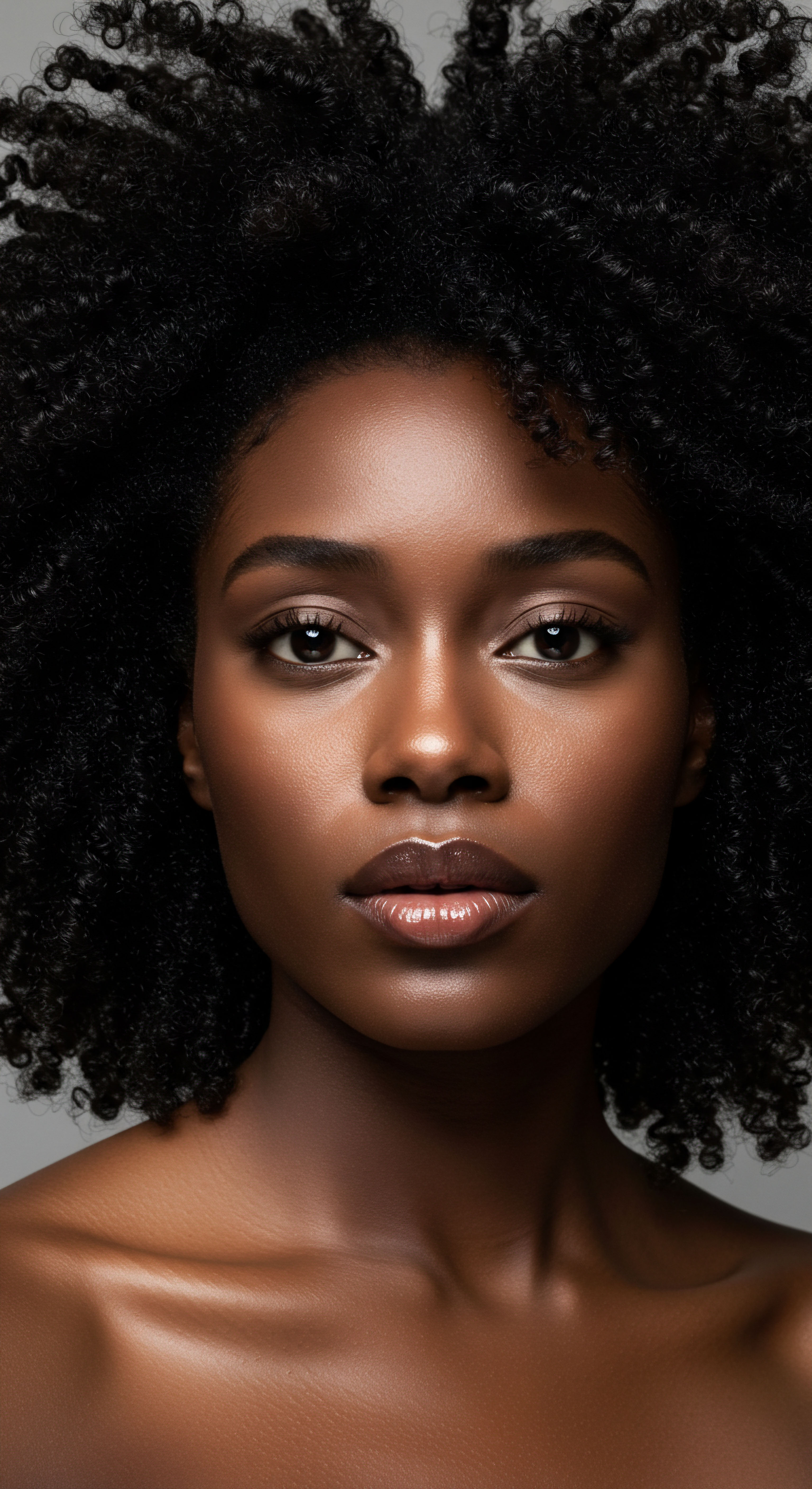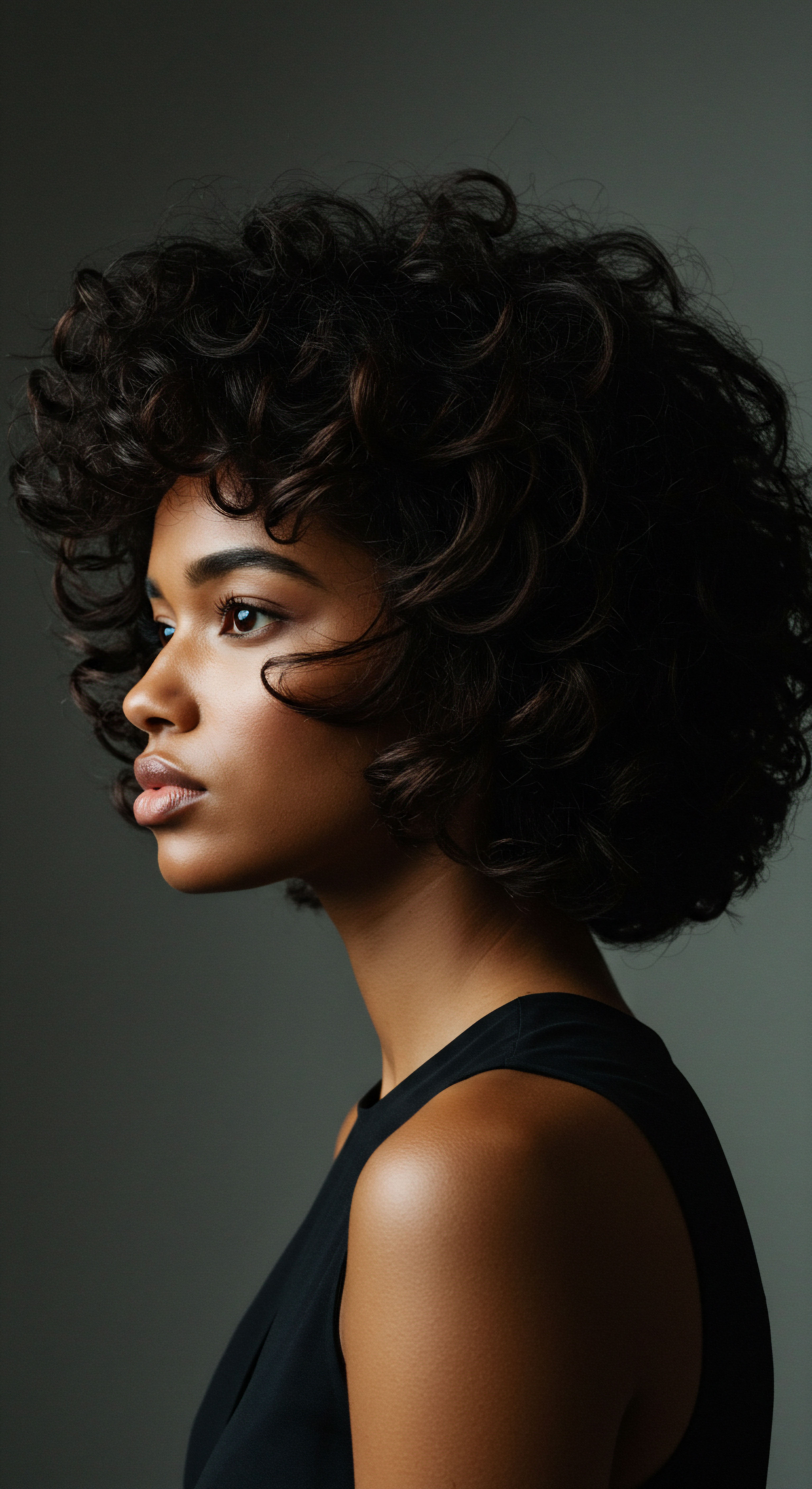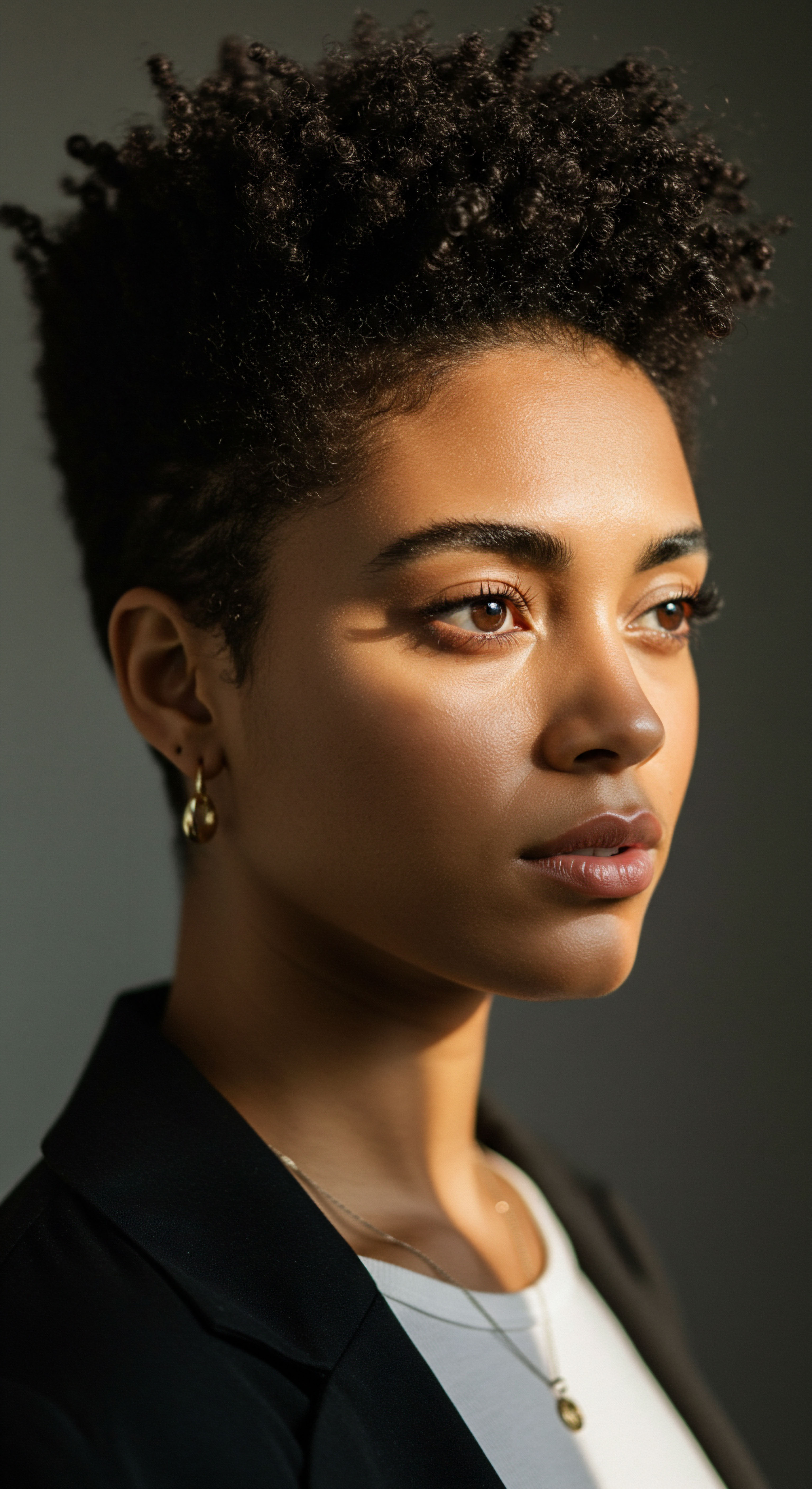
Roots
The vitality of our hair, particularly textured strands, holds a profound connection to our sense of self and heritage. It is a crown, a statement, and a delicate structure deserving of careful attention. Often, we hear whispers of protein treatments, a seemingly simple answer to myriad hair concerns, yet the conversation frequently pauses at the surface.
To truly care for our hair, we must look beyond the immediate gloss and delve into the fundamental workings of the hair fiber itself. Understanding the precise actions of protein, whether it graces the outer layers or finds its way deeper within, unveils a clearer path to enduring hair health.

The Hair’s Inner World
At its very base, each strand of hair is a complex biological marvel, a miniature pillar composed primarily of a specialized protein known as Keratin. This protein is a resilient, fibrous substance that gives hair its strength, elasticity, and shape. Imagine a tree trunk, sturdy and strong; that is akin to the hair’s cortex, densely packed with keratin proteins. Encasing this core is the cuticle, a protective outer layer made of overlapping, scale-like cells, much like shingles on a roof.
These scales, when healthy, lie flat, reflecting light and shielding the inner cortex from environmental stressors. Beneath the cortex, some hair types also possess a medulla, a soft, central core whose purpose is still being fully explored.
Hair, a complex biological structure, primarily consists of keratin protein, with the cuticle forming a protective outer shield and the cortex providing internal strength.
The structural integrity of hair relies heavily on the arrangement and chemical bonds within these keratin proteins. Disulfide bonds, strong covalent links, are particularly significant in maintaining the hair’s inherent shape and contributing to its mechanical resilience. Beyond these, weaker hydrogen and salt bonds also play a role, influencing hair’s elasticity and its interaction with moisture.
When these bonds are compromised, whether through chemical processes, heat styling, or even daily grooming, the hair can become weakened, prone to breakage, and susceptible to external damage. This understanding of hair’s foundational composition and its vulnerability sets the stage for appreciating how external applications of protein might offer support.

What Constitutes Hair’s Protein?
Hair’s strength is intimately linked to its keratin content. Keratin itself is not a single, monolithic entity; rather, it is a family of related proteins, specifically alpha-keratins in human hair, which are rich in the amino acid cysteine. These cysteine residues are crucial because they form the disulfide bonds that grant hair its remarkable durability. When hair is damaged, these bonds can break, leading to a loss of structural integrity.
When we discuss protein in hair care, we are often referring to proteins derived from various sources, such as wheat, soy, silk, collagen, or even animal keratin itself, which have been processed to be suitable for topical application. The processing often involves Hydrolysis, a chemical reaction that breaks down larger protein molecules into smaller fragments, known as peptides or amino acids. This reduction in size is a key factor in determining how these external proteins interact with the hair fiber.
- Keratin ❉ The dominant protein in hair, providing strength and resilience.
- Cuticle ❉ The outermost protective layer, resembling overlapping scales.
- Cortex ❉ The inner core, responsible for most of the hair’s mechanical strength.

Ritual
The rhythm of hair care, the careful selection of elixirs and balms, speaks to a desire for restoration and vibrancy. When contemplating protein for our hair, the ritual often involves choosing between products that promise a surface smoothing or a deeper strengthening. This distinction between coating and penetration becomes a central consideration in tailoring our hair care practices to truly meet our hair’s needs, moving beyond a simple act of application to a thoughtful, informed practice.

Do Protein Treatments Merely Coat or Truly Penetrate?
The journey of a protein molecule from a product bottle to the hair fiber is a complex one, influenced by its size and the hair’s condition. Protein Coating refers to the action of protein molecules, typically larger ones, adhering to the outer surface of the hair shaft, forming a protective film. This film can smooth the cuticle, add temporary shine, and provide a barrier against environmental elements. It’s a superficial action, offering immediate cosmetic improvements.
Conversely, Protein Penetration describes the movement of smaller protein fragments, like hydrolyzed proteins or peptides, into the inner layers of the hair, particularly the cortex. These smaller molecules are thought to slip past the cuticle scales and enter the hair’s core, where they can potentially reinforce weakened internal structures and contribute to the hair’s intrinsic strength and elasticity. This deeper action promises more lasting structural benefits.

Choosing Your Protein Ritual
Selecting the right protein treatment hinges on understanding your hair’s current state and your desired outcome. If your hair feels rough, appears dull, or experiences friction, a coating protein might offer the immediate smoothing and gloss it needs. Products containing larger, non-hydrolyzed proteins, or even certain silicones, are often designed for this purpose. They act as a temporary bandage, improving the hair’s outward appearance.
However, if your hair shows signs of significant damage, such as excessive breakage, loss of elasticity (hair that stretches too much without returning to its original shape), or has undergone chemical treatments like coloring or relaxing, then a protein that can penetrate the hair shaft may be more beneficial. These smaller, hydrolyzed proteins can help to fill in gaps and fortify the internal protein structure.
Hair care choices should align with whether your hair needs surface smoothing or internal structural support from proteins.
Consider this analogy ❉ a scratch on a wooden table. You could apply a clear polish to hide the scratch and give it a temporary sheen (coating), or you could fill the scratch with wood filler and then refinish the table for a more lasting repair (penetration). Both have their place, depending on the severity of the damage and the desired longevity of the solution.
| Protein Type Non-Hydrolyzed Protein (larger molecules) |
| Primary Action Coats hair surface |
| Observable Benefit Smoothness, shine, temporary protection |
| Protein Type Hydrolyzed Protein (smaller peptides) |
| Primary Action Penetrates hair cortex |
| Observable Benefit Increased strength, elasticity, reduced breakage |

Relay
To truly comprehend the dance between protein and hair, we must move beyond simple observation and into the intricate realm where molecular science meets lived experience. The question of whether proteins merely coat or genuinely penetrate the hair fiber is not a simple dichotomy, but rather a spectrum of interaction influenced by molecular size, hair porosity, and even the surrounding environment. This deeper understanding informs not only our product choices but also our appreciation for the resilience and specific needs of textured hair.

The Molecular Sizing of Protein’s Reach
The capacity of a protein to penetrate the hair shaft is directly proportional to its molecular weight. Hair, being a porous structure, has a selective barrier, primarily the cuticle, which regulates what enters and exits. Larger protein molecules, such as those found in non-hydrolyzed forms like whole keratin or collagen, generally remain on the surface. They create a film, offering external conditioning and a smoother feel.
In contrast, proteins that have undergone hydrolysis are broken down into smaller peptides or amino acids. These smaller fragments possess a greater likelihood of slipping through the minute openings in the cuticle and reaching the cortex. Research confirms that low molecular weight hydrolyzed proteins are more adept at penetrating the hair’s inner structures.
A study investigating the impact of different molecular weight hydrolyzed keratins on relaxed textured hair revealed that low and mid-molecular weight compounds (221 Da and 2577 Da, respectively) were able to penetrate deep into the hair cortex, while high molecular weight peptides (75,440 Da) largely adsorbed onto the surface. This finding underscores the importance of ingredient selection for targeted benefits.

Hair Porosity’s Role in Protein Absorption
Hair porosity, the hair’s ability to absorb and retain moisture, significantly impacts how protein treatments interact with the strands.
- Low Porosity Hair ❉ Possesses tightly bound cuticle layers, making it more resistant to penetration. For such hair, lighter, smaller hydrolyzed proteins might still find their way in, but larger coating proteins could build up on the surface, potentially leading to stiffness or product residue.
- Normal Porosity Hair ❉ Has moderately open cuticles, allowing for a balanced absorption and retention of moisture and products. This hair type generally responds well to a variety of protein treatments, benefiting from both coating and penetrating effects as needed.
- High Porosity Hair ❉ Characterized by raised or damaged cuticle layers, which allow moisture and products to enter easily but also escape quickly. This hair type often benefits most from penetrating proteins to help fortify weakened internal structures, while coating proteins can assist in smoothing the rough cuticle and sealing moisture.
The interplay of protein size and hair porosity dictates the efficacy of a treatment. For instance, chemically treated hair, often exhibiting high porosity due to damage, may benefit more from smaller, penetrating proteins that can help restore some internal integrity.

The Curious Case of Protein Overload
While protein offers considerable benefits, an excess can lead to an undesirable state often termed “protein overload.” This condition typically occurs when hair receives too much protein, particularly smaller, penetrating proteins, without adequate moisture balance. The hair can become stiff, brittle, and prone to breakage, feeling dry and straw-like despite conditioning efforts. This phenomenon is particularly relevant for textured hair, which can be inherently drier and more susceptible to moisture loss.
The mechanisms behind protein overload are still being fully explored, but one theory suggests that an excess of protein can make the hair overly rigid, reducing its natural elasticity. This rigidity can make the hair more susceptible to snapping under tension, a counterintuitive outcome for a treatment designed to strengthen. Finding the right balance between protein and moisture is a continuous act of listening to one’s hair.

A Deeper Look at Protein’s Influence on Textured Hair
Textured hair, with its unique helical structure and elliptical cross-section, presents distinct challenges and opportunities for protein treatments. The natural curves and coils mean that the cuticle layers may not lie as flat as on straight hair, potentially leaving more areas exposed to damage. This structural difference can also make it more challenging for natural oils from the scalp to travel down the entire length of the hair shaft, contributing to dryness.
Interestingly, recent proteomics research has even revealed that curly and straight hairs possess different compositions of keratin proteins. One study found that certain proteins are two to six times more prevalent in curly hair than straight hair, and these proteins are richer in specific amino acids like Glycine and Serine. This groundbreaking discovery suggests that the molecular building blocks themselves can vary, implying that the optimal protein treatments for textured hair might also possess unique amino acid profiles to truly align with its inherent composition. This shifts our perspective from a universal protein application to a more tailored approach, recognizing the biological distinctiveness of textured strands.
Protein interaction with hair depends on molecular size, hair porosity, and the unique biological composition of textured hair, influencing treatment efficacy.
The cultural context of textured hair care also plays a significant role. For generations, individuals with textured hair have sought ways to maintain its strength and health, often relying on traditional remedies and practices. The modern scientific understanding of protein interactions offers a valuable layer to this existing wisdom, allowing for more informed decisions.
A notable study from 2017, published in the Royal Society of Chemistry’s journal, explored the effect of recombinant human keratin K31 on chemically damaged and curly African hair. This research showed that when K31 protein was applied to chemically damaged hair, it increased the hair’s diameter by up to 49% and nearly doubled its mechanical strength after a single treatment. Furthermore, the protein effectively straightened curly hair for an hour with a single application.
This points to the potential of human-derived keratin proteins to not only repair but also temporarily alter the physical properties of textured hair, moving beyond simple coating or penetration to a more profound interaction with the hair’s inherent structure. While the study used recombinant protein and its implications for daily products require further exploration, it certainly challenges the simplistic view of protein treatments, suggesting a more dynamic and transformative capacity than often discussed.
Ultimately, the decision to use protein treatments, and the type of protein chosen, should stem from a deep understanding of your hair’s unique story – its structure, its current condition, and its response to various forms of care. It is a continuous dialogue between the strands and the hands that tend them.

Reflection
As we close this exploration of protein’s interaction with hair, it becomes clear that our understanding must stretch beyond simple categories of “coating” or “penetration.” The hair fiber, particularly the diverse and magnificent realm of textured hair, is a living canvas, responding to care with a sensitivity that invites a mindful approach. True hair health is not a rigid formula but a fluid conversation, a listening to the whispers of each strand. It is in this attentive engagement, combining scientific insight with intuitive care, that we truly begin to honor and support the innate beauty of our hair.

References
- Malinauskyte, A. (2010). Chemical and photochemical degradation of human hair ❉ A free-volume microprobe study. Journal of Photochemistry and Photobiology B ❉ Biology, 101, 286–294.
- Fan, J. Yu, W. Bian, M. Yue, Z. & Wang, J. (2024). Study on the efficacy and mechanism of an amino acid combination in hair care. China Surfactant Detergent and Cosmetics, 54.
- Coderch, L. Méndez, S. Martí, M. Ramos, J. & Barba, C. (2017). Hair lipids ❉ Composition and changes with treatments. Journal of Cosmetic Science, 68(1), 1-14.
- Robbins, C. R. (2012). Chemical and Physical Behavior of Human Hair (5th ed.). Springer.
- Dullaart, R. & Mousquès, J. (2012). Keratin ❉ Structure, Properties, and Applications. Nova Science Publishers, Incorporated.
- Kronberg, B. Holmberg, K. & Lindman, B. (2014). Surface Chemistry of Surfactants and Polymers (2nd ed.). Wiley.
- Rieger, M. M. (2000). Harry’s Cosmeticology (8th ed.). Chemical Publishing Company.
- Schueller, R. & Romanowski, P. (2017). Beginning Cosmetic Chemistry (3rd ed.). Allured Business Media.
- Popescu, L. & Haryu, A. (2012). Hair ❉ Testing, Process and Repair for the Cosmetic Industry. Chemical Publishing Company.
- Althea Gooden. (2024). What Are Hydrolyzed and Non-Hydrolyzed Proteins? Retrieved from Althea Gooden’s blog.
- Clinikally. (2023). Hydrolyzed Proteins for Hair Repair and Nourishment. Retrieved from Clinikally’s blog.
- FullyVital. (2023). Hydrolyzed Protein ❉ The Key To Strong And Healthy Hair. Retrieved from FullyVital’s blog.
- GK Hair UK. (2024). Discover the Power of Protein Treatment for Hair Health. Retrieved from GK Hair UK’s blog.
- Needs Hair Studio. (2025). The Science Behind Protein Hair Treatments ❉ Are They Worth It? Retrieved from Needs Hair Studio’s blog.
- Nexxus US. (2020). Facts About Curly Hair Protein & Chemistry. Retrieved from Nexxus US’s website.
- Hexis Lab. (2023). Genomic Variation in Textured Hair ❉ Implications for Holistic Hair Care. Retrieved from Hexis Lab’s website.
- Althea Gooden. (2024). What Are Hydrolyzed and Non-Hydrolyzed Proteins? Retrieved from Althea Gooden’s blog.
- Clinikally. (2023). Hydrolyzed Proteins for Hair Repair and Nourishment. Retrieved from Clinikally’s blog.
- FullyVital. (2023). Hydrolyzed Protein ❉ The Key To Strong And Healthy Hair. Retrieved from FullyVital’s blog.
- GK Hair UK. (2024). Discover the Power of Protein Treatment for Hair Health. Retrieved from GK Hair UK’s blog.
- Needs Hair Studio. (2025). The Science Behind Protein Hair Treatments ❉ Are They Worth It? Retrieved from Needs Hair Studio’s blog.
- Nexxus US. (2020). Facts About Curly Hair Protein & Chemistry. Retrieved from Nexxus US’s website.
- Hexis Lab. (2023). Genomic Variation in Textured Hair ❉ Implications for Holistic Hair Care. Retrieved from Hexis Lab’s website.
- Cleveland Clinic. (2022). Keratin ❉ Protein, Structure, Benefits, Uses & Risks. Retrieved from Cleveland Clinic’s website.
- Althea Gooden. (2024). What Are Hydrolyzed and Non-Hydrolyzed Proteins? Retrieved from Althea Gooden’s blog.
- Clinikally. (2023). Hydrolyzed Proteins for Hair Repair and Nourishment. Retrieved from Clinikally’s blog.
- Malinauskyte, A. & Williams, S. R. (2017). Changing the shape of hair with keratin peptides. RSC Advances, 7(82), 52140-52148.
- Fan, C. Shi, J. Wei, X. & Yunjun, Y. (2025). Proteins as Hair Styling Agents. Molecules, 30(5), 1182.
- Malinauskyte, A. & Williams, S. R. (2017). Changing the shape of hair with keratin peptides. RSC Advances, 7(82), 52140-52148.
- Fan, C. Shi, J. Wei, X. & Yunjun, Y. (2025). Proteins as Hair Styling Agents. Molecules, 30(5), 1182.